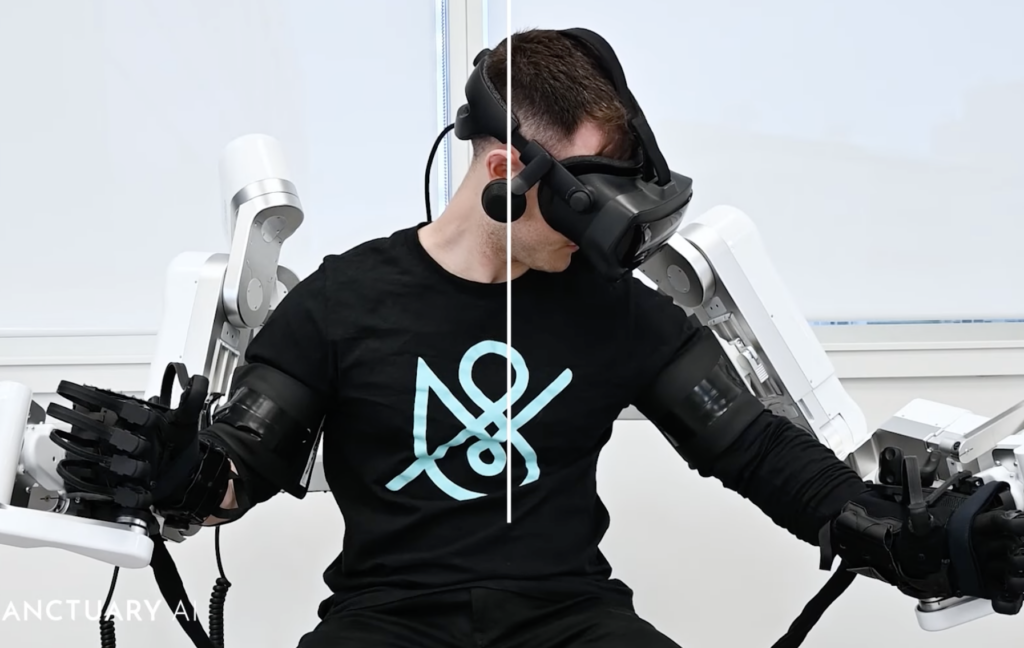Sanctuary AI is a Canadian humanoid robotics company iwth over 100 million in funding. They want to create the world’s first human-like intelligence in general-purpose robots that will help us work more safely, efficiently, and sustainably. Sanctuary AI general-purpose robots can be operated in three modes: directly piloted by people; operated by people using pilot-assist; and supervised by people while using the robot’s built-in autonomous control system to observe, assess, and act on tasks. they have virtual reality goggles for the human operators to see what the robots see. Teleoperation is for more complex tasks and for trouble shooting issues.






Brian Wang is a Futurist Thought Leader and a popular Science blogger with 1 million readers per month. His blog Nextbigfuture.com is ranked #1 Science News Blog. It covers many disruptive technology and trends including Space, Robotics, Artificial Intelligence, Medicine, Anti-aging Biotechnology, and Nanotechnology.
Known for identifying cutting edge technologies, he is currently a Co-Founder of a startup and fundraiser for high potential early-stage companies. He is the Head of Research for Allocations for deep technology investments and an Angel Investor at Space Angels.
A frequent speaker at corporations, he has been a TEDx speaker, a Singularity University speaker and guest at numerous interviews for radio and podcasts. He is open to public speaking and advising engagements.


There’s a kind of structural support trick for the landing frame of flying drones, that might make service robots (or TELE-WALDO?) a lot more lightweight. The drone makers use hollow metal tubes to be the support legs or landing frame, instead of SOLID metal rods, which would be functional , but also HEAVY, so they stuff the tubes with hollow glass beads, so that it’s stronger than a hollow tube version, but be lighter so the drone can fly easier. So, if we make most of structural support sections of these new generations of robots hollow metal shells, but stuffed them full of hollow balls, of VARYING sizes, one size ball the largest, another size ball smaller, and a smallest ball size, all crammed inside the metal tubes or supported sections of the robot, to fully occupy every nook and cranny of space inside of the tubes. These ‘Cranny balls’ would be made of miscellaneous materials, depending on the weight-lifting job requirements of that specific robot model, that would make the robot structurally strong enough, but with less weight and amount of materials needed to manufacture them, and less electricity power to move them about. EOJ
What you’re talking about is ‘metal foam’ equivalent to styrofoam. The little hollow spheroids of metal compress well, hydraulically. So, if they’re all coated with a time-setting (thin, nanofibre filled) epoxy BEFORE compression, then compressed before curing, the resulting tubes would be extraordinarily strong. Not quite as strong as solid metal, but certainly approaching 50% as strong. And 10x to 30x stronger per unit mass. Win!
However, this doesn’t really make the robot more achievable. Given the initial price tag would be in the sub-millions to multi-millions, making it all out of aircraft aluminum and titanium would do the job completely, without the ridiculous sourcing issues of styrometal.
Just … saying
These are called waldos as I recall
Make the Teleoperation device a wearable human motion recorder put it on 1 million people for a year and you will have the training data to have a robot equal to a human.